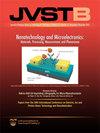Numerical analysis of pattern shape deformation in UV imprint considering thermal deformation with UV shrinkage and curing
IF 1.4
4区 工程技术
引用次数: 0
Abstract
A novel numerical method for analyzing the deformation of molding patterns on UV imprint with soft molds considering thermal deformation in addition to UV shrinkage and curing is presented. In the case of UV imprint using an easily deformable mold-like PDMS, transfer error on UV resin is caused by thermal expansion/contraction arising from UV reaction heat and by UV shrinkage. Specifically, when a UV resin with high reaction heat such as cation polymerization-type UV resin is used, thermal deformation has a nonnegligible effect on pattern shape deformation. Therefore, it is necessary to consider thermal deformation caused by UV reaction heat in the numerical deformation analysis of UV imprint requiring high surface accuracy, such as optical devices. The present method newly adopts the theory of reaction rate to consider the temperature-dependent UV reaction rate and introduces an advanced idea of virtual temperature as a measure of UV reaction progress. By defining the time histories of thermal deformation and UV shrinkage as a function of virtual temperature, the effects of both are considered simultaneously. In order to apply the present method to actual imprints, temperature measurement experiments and various rheometry experiments are conducted on a target UV resin to identify its model parameters. A validation analysis of the present method is performed on an actual micromirror array imprint and shows that the simulation accuracy of transfer error can be significantly improved by considering thermal deformation.考虑UV收缩和固化热变形的UV压印图案形状变形的数值分析
提出了一种考虑热变形、UV收缩和固化的软模UV压印成型图案变形分析的新数值方法。在使用易变形的模状PDMS进行UV压印的情况下,UV树脂上的转移误差是由UV反应产生的热膨胀/收缩和UV收缩引起的。具体来说,当使用阳离子聚合型UV树脂等高反应热的UV树脂时,热变形对图案形状变形的影响是不可忽略的。因此,在光学器件等对表面精度要求较高的UV压印的数值变形分析中,有必要考虑UV反应热引起的热变形。该方法采用反应速率理论来考虑与温度有关的紫外反应速率,并引入了虚拟温度作为紫外反应进程度量的先进思想。通过将热变形和紫外线收缩的时间历程定义为虚拟温度的函数,可以同时考虑两者的影响。为了将该方法应用于实际印痕,对目标UV树脂进行了温度测量实验和各种流变实验,以确定其模型参数。在实际微镜阵列压印上对该方法进行了验证分析,结果表明,考虑热变形可以显著提高传递误差的仿真精度。
本文章由计算机程序翻译,如有差异,请以英文原文为准。
求助全文
约1分钟内获得全文
求助全文
来源期刊

Journal of Vacuum Science & Technology B
工程技术-工程:电子与电气
自引率
14.30%
发文量
0
审稿时长
2.5 months
期刊介绍:
Journal of Vacuum Science & Technology B emphasizes processing, measurement and phenomena associated with micrometer and nanometer structures and devices. Processing may include vacuum processing, plasma processing and microlithography among others, while measurement refers to a wide range of materials and device characterization methods for understanding the physics and chemistry of submicron and nanometer structures and devices.
 求助内容:
求助内容: 应助结果提醒方式:
应助结果提醒方式:


